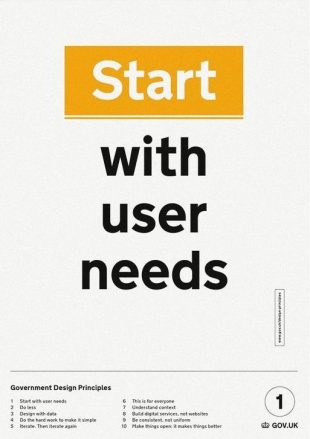Pete Bates, a Content Designer at BPDTS, based in Newcastle, explains why designing with policy helps create better services. Part of Pete’s work is to ensure the service team with whom he works has the information they need. Asking the right questions, in a way that makes sense, improves the user journey by highlighting the essential information citizens need.
I'm a Content Designer at BPDTS, based in Newcastle. I work in Retirement, Bereavement and Care. Our teams work on the benefits and payments that people need when they retire, or something unexpected happens in their lives.

As a content designer, I work on the end-to-end journey that a user takes through a service. I make sure a user understands enough to complete their goal and get what they need.
I need to work with people in different parts of the department, including policy colleagues, to make sure the policy intent of government is delivered in a way that makes sense to people who aren’t specialists. I do this by creating, changing and removing content so that people get the information they need at the right time and in the right place.
User-centred design teams
Part of my job on a service team is to make sure people have the information they need when they need it. I ask people questions in a way that makes sense to them and to help them give us only the information we need.
I work with lots of different people. Business analysts, a user researcher, an interaction designer and me, a content designer. We have several engineers and testers, operational subject matter experts and crucially, our very own policy person, Kevin.
We're very lucky to have Kevin embedded in the team. Not just because he's a lovely bloke, but because working so closely has real benefits for us and our users. I didn't always know that. I might have even thought at one point that a policy person would put the brakes on stuff and make designing things really difficult. Another person to sign things off; but, that thought didn't last long.
What is policy
Policy is the application of legislation. Legislation is difficult to change. Policy is too. Not as difficult, but still not easy. Some legislation and policies existed well before we started designing digital services, but given the right evidence of user need, policies and legislation can be changed, not simply reinterpreted.
Having someone from policy, who has an understanding of what digital colleagues are trying to achieve is useful in turning that evidence into formulated policy arguments that convince ministers.
Whether the policy person is embedded on your team, or you work with them for more of a distance, the absolute need is to make sure the work we're doing is within the rules. In service design, there's a lot more than that. There's a huge benefit to having the perspective and expertise involved right from the start.
What problems are you trying to solve?
By understanding problems and making decisions together, you can get where you need to be quicker. It's the difference between asking for sign-off and finding the best way to solve a problem together. Every role in service design (and probably beyond!) tries to claim the mantra, 'come to me with problems, not solutions' as their own. That's true for policy colleagues too.
When is a policy not a policy?
When it's an operation implementation of a policy, a lot of the benefits we work on have been around for a long time. We're never the first people to work on them, to have ideas and change things to try and make them better. We're always transforming things, digitally and otherwise, years and years, layers and layers of making things better.
'We've always done it that way'
It's easy to fall into the trap of replicating a set of questions or a process that's already there. It's easy to think that there must be a reason that those questions are there.
By having the right people to work with, we can peel away layers. There might be a spreadsheet of questions that was built 8 years ago to solve a problem quickly, that was rolled out into a standard working instruction. That's not a policy. Those reasons might not exist anymore.
Working with policy, you can strip these things away. Things worked at the time and served a purpose, but policy doesn't dictate that we have to do things in the same way.
Here's why designing with policy creates better services:
#1 You can stop working from assumptions that might not be correct
#2 You can change your plans in the right way, at the right time
#3 You can solve a whole problem for users, from the right starting point
Bring policy people in early
Policy people aren't just there for sign-off. They're much more than a rubber stamp. Usually, it's not the first time someone's worked on the problem that you're trying to solve. It's likely that a policy person was involved at that time.
Work together end-to-end
Work together from start to finish. If you have someone with experience either on your team or available to you, why wouldn't you use that experience? Don't assume that policy can only be implemented in one way.
Peel away the layers
Don't assume that you're starting from the right place, take the time to work together and strip the problem back to the policy, or even at the primary legislation if you can. Start from the beginning. As well as working with Kevin day-to-day, we hold regular show and tells with all of our stakeholders, including other people from the policy community.
Take everyone on the journey
There are always other stakeholders asking questions, giving us advice and letting us know about any concerns that they have right at the start. Doing it this way helps us go through all the design phases together and get things right.
Taking everyone on the journey with you means there are no surprises, if anyone needs to intervene, it's better that there's a slight swerve at the right time, rather than someone putting the brakes on right when it's the last thing that you need. Working like this can turn something that could be a major headache into a productive relationship between design, development and policy.
Embrace the mind shift
It's a shift in mindset, a lot of the time. There are a lot of governance steps that you have to take and assessments that you have to pass. If you stop treating them as hoops that you have to jump through and view them as tools that you can use to make your product better life gets a lot easier.
A smoother future
What government is trying to work towards is end-to-end service design, starting with what users need, when they need it.

That includes the design of the policies that determine how benefits work. By designing a policy starting with what our citizens need, when they need it, we can design more effective policies that work for government and citizens. Designing a policy like this makes us more mobile as a society. We can see what's working and what isn't at a citizen level and quickly change when we see things aren't working any more.
For now, we have to design with existing policy in mind. We can influence it, and we can request changes, or just work towards the best way to implement it and make things run more smoothly. It's important we keep pushing for what's right, and not just what's easy. And in the meantime, you could do worse than have a Kevin on your team. Not our Kevin though; hands off.
Stakeholder relationship management
One of the key skills of a content designer is stakeholder relationship management. By establishing these relationships, we often find that design and policy are working towards the same goal from slightly different directions. This is critical to helping some of the most vulnerable people in society get the help they need, without having to understand the rules and legislation behind that help. It's only through establishing those critical relationships across a team, including Policy, that enable a design team to deliver.
Learn more
For more information about our company, visit and connect with us on LinkedIn, and follow us on Twitter.
Stay up to date with what’s happening at BPDTS. Sign up for email updates whenever new content is posted.
Are you thinking of joining us? Please have a look at our current job openings.
Leave a comment